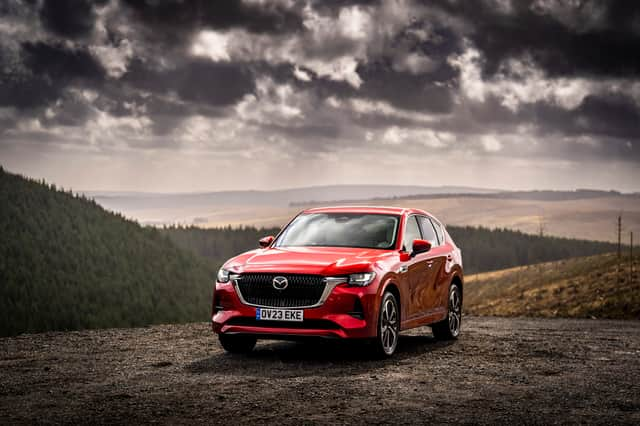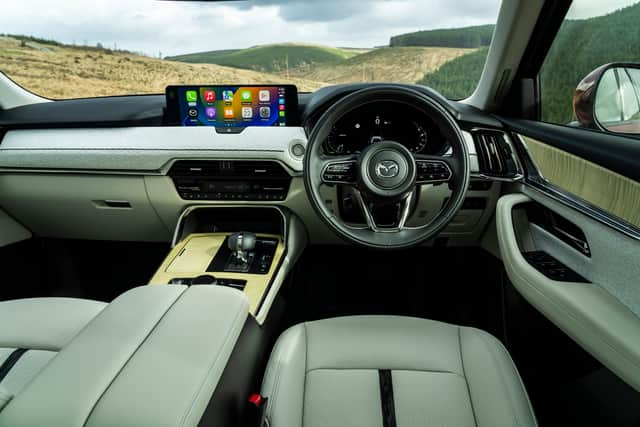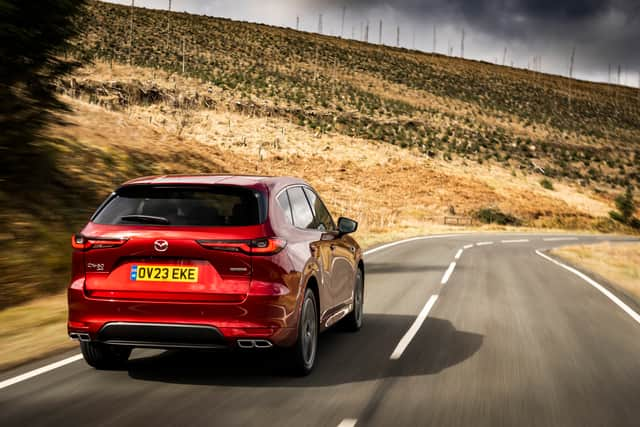2023 Mazda CX-60 Diesel review: A new direction or end of the road for big diesels?


The new car market in the UK and Europe is clearly heading in one direction at the moment, with new electric models arriving regularly and sales of EVs soaring as diesels disappear.
But Mazda isn’t buying into the “everything electric all at once” narrative. It argues that different uses and markets need different solutions, including the continued presence of diesel powertrains.
Advertisement
Hide AdAdvertisement
Hide AdWhile diesel is undoubtedly unfashionable - registrations of new diesels fell 39% last year - Mazda believes there is still a place for it in large SUVs like the CX-60 where owners might cover high mileages or regularly tow trailers or caravans. And it’s not alone. Look at its target rivals - Audi Q5, BMW X3, Mercedes GLC, Genesis GV70 - and you’ll still find oil-burning options. But while they’re mostly four-cylinder units, Mazda has supersized the CX-60 with a 3.3-litre mild hybrid straight six, arguing that the large capacity’s extra torque (up to 406lb ft) offers the best economy for a large vehicle.
The official figures put the CX-60’s consumption at 56.5mpg for the less-powerful two-wheel-drive variant and 53.3mpg for the 251bhp four-wheel drive. Our admittedly challenging test route through rural Scotland threw up less impressive averages in the low 40s.
The aforementioned premium car makers have reached the point where their diesels, even four-pots, are so well insulated and muffled that they’re barely noticeable. Not in the Mazda. Under heavy throttle and at higher revs it smooths out into a reasonably deep bellow but below 2,500rpm it clatters and rattles like an old Transit van.
In comparison to the plug-in hybrid version - itself not the most refined drivetrain - it feels like a backwards step. Which is a shame because, the noise aside, it’s a decent engine. There’s not much physical vibration transmitted to the cabin, the eight-speed automatic gearbox is smooth and in the higher-powered tune it feels pretty muscular.
Advertisement
Hide AdAdvertisement
Hide AdThe 197bhp doesn’t feel slow but you’re aware of the extra grunt of the 251bhp version and the way it puts that down via all four wheels to make quicker progress on the twisting, undulating roads of our test route. It also feels more sure-footed picking its way through the mud, puddles and potholes.
Some of those potholes proved tricky to avoid, allowing us plenty of scope to test the CX-60’s ride comfort. This flagship SUV has a softer edge than other Mazdas, which means passengers are well insulated from the discomfort created by crumbling roads and sharp edges. We’re not talking Citroen levels of marshmallow squishiness but enough to offer a refined and comfortable ride.


That does mean the CX-60 isn’t as dynamic as its smaller siblings and you’re more conscious of its size. From the wheel you’re always aware that this is a tall, heavy and wide car. It doesn’t shrink around you in the way that the CX-5 does but it still feels composed on very challenging roads.
Away from the drivetrain, the diesel CX-60 line-up matches that of the plug-in version. Three well-equipped trim levels start at £42,990 for the 197bhp Exclusive-Line, rising to £48,380 for the Homura and topping out at £50,730 for the Takumi, both of which come exclusively with the more powerful all-wheel-drive setup.
Advertisement
Hide AdAdvertisement
Hide AdThese prices are all part of Mazda’s efforts to be taken seriously as an alternative to BMW, Audi, Mercedes and more. As is the attention dedicated to the interior. Some of the controls and switches are standard Mazda parts but many elements, including the maple wood and beautiful hanging-stitch pattern on the Takumi grade’s dashboard, are bespoke for the CX-60. Mazda interiors have long felt like a cut above the mainstream and the CX-60 strengthens that impression with rock-solid build quality, a simple choice of attractive, tactile materials and a design focused on being easy to use rather than slavishly following the touchscreen trend.
It also offers plenty of space for everyone onboard. The CX-60’s extra 17cm in length and 4.5cm width over the CX-5 is apparent inside, where there’s generous leg and shoulder room for everyone, plus a 570-litre boot that’s better than most alternatives.


Mazda is very open that it is going after the established European premium brands with the CX-60. As a first attempt it’s an admirable effort. It’s roomy, comfortable, well equipped and with a high-end sheen that sets it on the path towards premium contendership, even if it’s no 100% there yet.
The biggest obstacle to the CX-60’s premium aspirations is that engine. The more powerful version has the oomph to move the car nicely and fulfils the brief of offering a long-range and capable tow vehicle but it simply isn’t refined or frugal enough to make a convince case for itself.
Mazda CX-60 Diesel Takumi
Advertisement
Hide AdAdvertisement
Hide AdPrice: £53,350; Engine: 3.3-litre, six-cylinder, mild hybrid, diesel; Power: 251bhp; Torque: 406lb ft; Transmission: Eight-speed automatic; Top speed: 136mph; 0-62mph: 7.4 seconds; Economy: 53.3mpg; CO2 emissions: 139g/km
Comment Guidelines
National World encourages reader discussion on our stories. User feedback, insights and back-and-forth exchanges add a rich layer of context to reporting. Please review our Community Guidelines before commenting.
